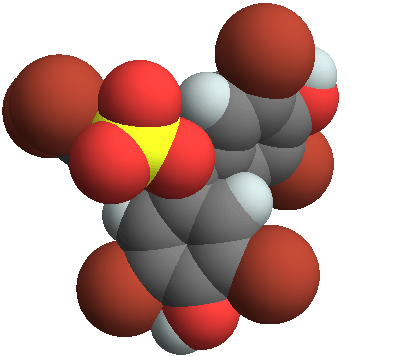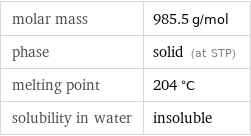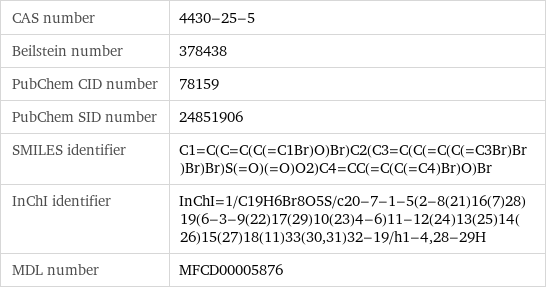Input interpretation

tetrabromophenol blue
Chemical names and formulas
![formula | C_19H_6Br_8O_5S name | tetrabromophenol blue IUPAC name | 2, 6-dibromo-4-[4, 5, 6, 7-tetrabromo-3-(3, 5-dibromo-4-hydroxyphenyl)-1, 1-dioxo-3-benzo[c]oxathiolyl]phenol alternate names | 2, 6-dibromo-4-[4, 5, 6, 7-tetrabromo-3-(3, 5-dibromo-4-hydroxy-phenyl)-1, 1-diketo-benzo[c]oxathiol-3-yl]phenol | 2, 6-dibromo-4-[4, 5, 6, 7-tetrabromo-3-(3, 5-dibromo-4-hydroxy-phenyl)-1, 1-dioxo-benzo[c][1, 2]oxathiol-3-yl]phenol | 2, 6-dibromo-4-[4, 5, 6, 7-tetrabromo-3-(3, 5-dibromo-4-hydroxy-phenyl)-1, 1-dioxo-benzo[c]oxathiol-3-yl]phenol | 2, 6-dibromo-4-[4, 5, 6, 7-tetrabromo-3-(3, 5-dibromo-4-hydroxyphenyl)-1, 1-dioxobenzo[c]oxathiol-3-yl]phenol | 3, 3', 3'', 4, 5, 5', 5'', 6-octabromophenolsulfonphthalein | bromphenol blue mass fractions | Br (bromine) 64.9% | C (carbon) 23.2% | H (hydrogen) 0.614% | O (oxygen) 8.12% | S (sulfur) 3.25%](../image_source/f6aabb88da01345cc122c2c2e05b271b.png)
formula | C_19H_6Br_8O_5S name | tetrabromophenol blue IUPAC name | 2, 6-dibromo-4-[4, 5, 6, 7-tetrabromo-3-(3, 5-dibromo-4-hydroxyphenyl)-1, 1-dioxo-3-benzo[c]oxathiolyl]phenol alternate names | 2, 6-dibromo-4-[4, 5, 6, 7-tetrabromo-3-(3, 5-dibromo-4-hydroxy-phenyl)-1, 1-diketo-benzo[c]oxathiol-3-yl]phenol | 2, 6-dibromo-4-[4, 5, 6, 7-tetrabromo-3-(3, 5-dibromo-4-hydroxy-phenyl)-1, 1-dioxo-benzo[c][1, 2]oxathiol-3-yl]phenol | 2, 6-dibromo-4-[4, 5, 6, 7-tetrabromo-3-(3, 5-dibromo-4-hydroxy-phenyl)-1, 1-dioxo-benzo[c]oxathiol-3-yl]phenol | 2, 6-dibromo-4-[4, 5, 6, 7-tetrabromo-3-(3, 5-dibromo-4-hydroxyphenyl)-1, 1-dioxobenzo[c]oxathiol-3-yl]phenol | 3, 3', 3'', 4, 5, 5', 5'', 6-octabromophenolsulfonphthalein | bromphenol blue mass fractions | Br (bromine) 64.9% | C (carbon) 23.2% | H (hydrogen) 0.614% | O (oxygen) 8.12% | S (sulfur) 3.25%
Lewis structure

Draw the Lewis structure of tetrabromophenol blue. Start by drawing the overall structure of the molecule, ignoring potential double and triple bonds: Count the total valence electrons of the bromine (n_Br, val = 7), carbon (n_C, val = 4), hydrogen (n_H, val = 1), oxygen (n_O, val = 6), and sulfur (n_S, val = 6) atoms: 8 n_Br, val + 19 n_C, val + 6 n_H, val + 5 n_O, val + n_S, val = 174 Calculate the number of electrons needed to completely fill the valence shells for bromine (n_Br, full = 8), carbon (n_C, full = 8), hydrogen (n_H, full = 2), oxygen (n_O, full = 8), and sulfur (n_S, full = 8): 8 n_Br, full + 19 n_C, full + 6 n_H, full + 5 n_O, full + n_S, full = 276 Subtracting these two numbers shows that 276 - 174 = 102 bonding electrons are needed. Each bond has two electrons, so in addition to the 42 bonds already present in the diagram we expect to add 9 bonds. To minimize formal charge oxygen wants 2 bonds and carbon wants 4 bonds. Identify the atoms that want additional bonds and the number of electrons remaining on each atom: Add 9 bonds by pairing electrons between adjacent highlighted atoms. Additionally, atoms with large electronegativities can minimize their formal charge by forcing atoms with smaller electronegativities on period 3 or higher to expand their valence shells. The electronegativities of the atoms are 2.20 (hydrogen), 2.55 (carbon), 2.58 (sulfur), 2.96 (bromine), and 3.44 (oxygen). Because the electronegativity of sulfur is smaller than the electronegativity of oxygen, expand the valence shell of sulfur to 6 bonds. Therefore we add a total of 11 bonds to the diagram. Note that the six atom rings are aromatic, so that the single and double bonds may be rearranged: Answer: | |
3D structure

3D structure
Basic properties

molar mass | 985.5 g/mol phase | solid (at STP) melting point | 204 °C solubility in water | insoluble
Units

Solid properties (at STP)

vapor pressure | 6×10^-22 mmHg (at 25 °C)
Units

Chemical identifiers

CAS number | 4430-25-5 Beilstein number | 378438 PubChem CID number | 78159 PubChem SID number | 24851906 SMILES identifier | C1=C(C=C(C(=C1Br)O)Br)C2(C3=C(C(=C(C(=C3Br)Br)Br)Br)S(=O)(=O)O2)C4=CC(=C(C(=C4)Br)O)Br InChI identifier | InChI=1/C19H6Br8O5S/c20-7-1-5(2-8(21)16(7)28)19(6-3-9(22)17(29)10(23)4-6)11-12(24)13(25)14(26)15(27)18(11)33(30, 31)32-19/h1-4, 28-29H MDL number | MFCD00005876